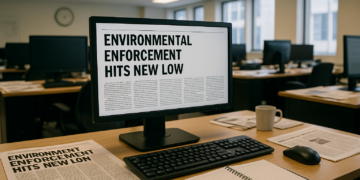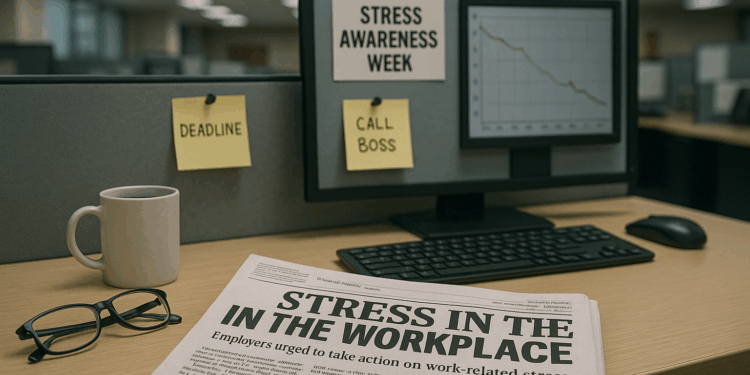Story Highlight
– Work-related stress is a leading cause of ill health.
– 776,000 workers reported stress, depression, or anxiety in 2023/24.
– Employers must assess and manage stress risks legally.
– HSE provides tools to promote employee wellbeing effectively.
– Normalizing stress discussions improves health and productivity.
Full Story
As Stress Awareness Week 2025 commences, attention is being drawn to the significant impact of work-related stress on employee health and wellbeing. The Health and Safety Executive (HSE) emphasises that managing stress in the workplace is not merely a recommendation but a legal obligation for employers.
Recent statistics from the HSE reveal that in 2023/24, approximately 776,000 individuals reported experiencing work-related stress, depression, or anxiety. This figure represents nearly half of all self-reported health issues associated with work, resulting in an estimated loss of 16.4 million working days. The consequences of unmanaged stress extend beyond the individual, impacting organisational productivity and increasing employee turnover rates.
It is crucial for employers to understand their responsibilities regarding workplace stress. According to both the Health and Safety at Work Act 1974 and subsequent regulations, employers are required to assess and mitigate risks to health and safety, which includes the mental wellbeing of their staff. This obligation means that proactive measures should be taken to identify and address work-related stress before it escalates.
The HSE provides resources through its Working Minds campaign, which offers employers straightforward guidance on addressing workplace stress. Central to this initiative are the “5 Rs” that outline an effective approach:
1. **Reach out**: Initiate conversations concerning stress.
2. **Recognise**: Identify signs and sources of stress within the workforce.
3. **Respond**: Agree on actionable steps and implement necessary changes.
4. **Reflect**: Assess the effectiveness of these actions.
5. **Make it Routine**: Integrate wellbeing practices into daily operations.
“Prevention is better than cure,” states Kayleigh Roberts, HSE’s Work-Related Stress Policy Lead, highlighting the advantages of taking early action. By being proactive, employers not only safeguard their employees’ health but also enhance retention rates of skilled individuals by reducing sickness absence.
During Stress Awareness Week, various actions can be undertaken by employers to support their staff. One effective tool is the Talking Toolkit, which encourages dialogue about critical factors that contribute to stress including demands, control, support, relationships, role clarity, and change management. Employers are urged to be vigilant for early signs of stress such as increased absenteeism, diminished performance levels, or interpersonal conflicts. Addressing these issues promptly can prevent them from escalating.
Furthermore, normalising conversations around stress should be integrated into routine health and safety procedures. Such an approach not only ensures compliance with legal obligations but also fosters a healthier and more resilient workforce.
This awareness initiative is supported by partners like Mind, which highlights the pressing need for open discussions about stress. Jonathan Stuart, the Workplace Partnerships Lead at Mind, stated, “Life can feel challenging for many of us, both in and outside of work. That’s why it’s so important that work doesn’t add to the pressure. As a proud Working Minds partner, Mind is supporting employers and workers to prevent work-related stress and create mentally healthy workplaces.”
As the week progresses, spreading awareness and encouraging discussion about stress in the workplace can further foster a culture of wellbeing. Conversations can occur in team meetings and during one-on-one sessions, reinforcing the message that mental health is as vital as physical health in the working environment.
Engaging with and amplifying the Working Minds campaign on social media can also help keep this crucial dialogue alive. By keeping the spotlight on workplace stress, employers can take significant strides toward creating supportive environments where their employees can thrive both professionally and personally. By prioritising mental health and taking these steps, organisations can build a more fulfilled, healthier, and productive workforce.























Essential reminder that preventing work related stress is a legal duty as well as a moral one. Employers should use a structured approach to identify pressures, assess risks, and put in place realistic, timely controls. Normalising conversations about mental health, involving staff in finding solutions and training managers to spot and respond to early signs will reduce harm, absence and presenteeism. Regular review of measures and clear records of decisions and actions help show compliance and improve outcomes.
Important reminder. Employers must assess and control risks from work related stress as they would any other workplace hazard. Practical steps include identifying sources of pressure through regular conversations and surveys, addressing workloads and role clarity, training managers to recognise and respond to early signs, and providing clear routes to support and adjustments. Recording actions and reviewing their effectiveness shows legal compliance and helps reduce absence and turnover. Normalising open discussions about mental health and using a structured approach makes it easier to protect wellbeing and maintain a productive workforce.
Important reminder that managing work related stress is a legal obligation as well as a moral one. Normalising conversations about mental health and adopting a clear, practical framework helps identify pressures early, target the causes of stress and put in controls that reduce harm. Employers should ensure risk assessments capture psychosocial hazards, involve workers in finding solutions, provide appropriate training for managers and monitor effectiveness. Doing so protects staff, reduces absence and supports sustainable performance.
This is an important reminder that managing work related stress is not optional. Employers must assess risks, consult with staff, and put in place practical measures to prevent and reduce stressors such as excessive workloads, unclear roles, poor support and unreasonable deadlines. Normalising conversations about mental health and training managers to spot and respond to signs of stress are essential steps. Regular review of interventions, timely adjustments and clear reporting routes help demonstrate compliance and protect both people and the business.